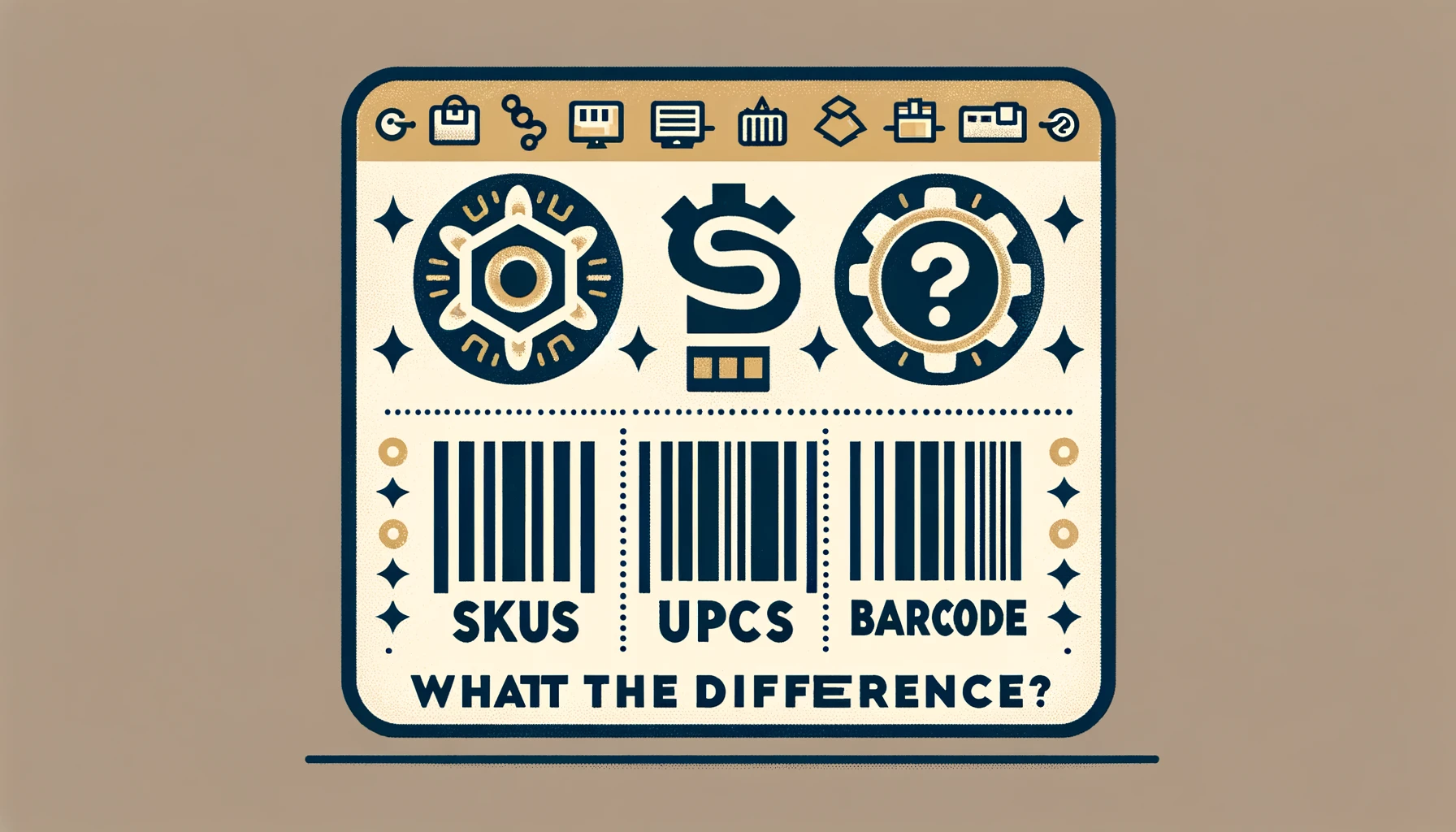SKUs, UPCs, and Barcodes: What’s the Difference?
When it comes to the business world and creating, purchasing, and shipping products, understanding the difference between SKU, UPC, and barcode is essential. Despite these terms often being used interchangeably or incorrectly, there are distinct differences between each that can have serious consequences if gone unnoticed.
This blog post will guide you on the basic differences between these terms and how to use them in your business.
What is an SKU?
If you’re a business owner, chances are you’ve heard of SKUs. But do you know what they are and how they can help your business?
An SKU, a “stock-keeping unit,” is a unique combination of numbers or letters identifying a specific product or variation.
It tracks inventory levels, pricing information, and other details about products and services. A good way to think of SKUs is as product identifiers, i.e., they help identify each item in your store so that you can accurately track inventory levels and pricing.
How Do Retailers & E-commerce Sellers Use SKUs?
Retailers and e-commerce sellers use SKUs to keep track of their products. By assigning each item a unique number or code, retailers can easily organize their inventory. They easily manage their stock levels for both online sales and in-store purchases.
Many retailers also use SKUs to manage pricing information for different variations of the same product; this helps them quickly adjust prices when needed without manually changing each product listing.
Finally, some retailers may even use customized SKUs to include additional information such as attributes (e.g., size or color). This makes it easier for customers to quickly find the exact item they’re looking for without having to search through multiple listings on the website or in-store shelves.
What is a Barcode?
A barcode is a visual, machine-readable code used to represent data in various industries. They identify and track products, items, and information quickly and efficiently.
Barcodes are widely used in the retail supply chain, healthcare, manufacturing, logistics, and other industries to improve productivity, reduce errors, and increase accuracy.
Different Formats of Barcodes
Barcodes can come in different formats and symbologies depending on their intended use. There are many types of barcodes, and here we are going to discuss some of these.
1D or Linear barcodes
One-dimensional (1D) barcodes, also known as linear barcodes, are the most common type of barcode. They consist of a series of parallel lines and spaces that encode information in varying widths and spacing. These barcodes can be further categorized as one-dimensional numeric and one-dimensional alpha-numeric.
1D Numeric
One-dimensional numeric barcodes, also known as linear barcodes, are a type of barcode that use a series of numbers to represent product information.
They are the most common type of barcode used on most consumer goods and are typically seen as a series of vertical lines of varying widths with numbers displayed beneath them.
The most well-known example of a 1D numeric barcode is the Universal Product Code (UPC), which is used to identify products for sale in retail stores in North America.
Aplha-Numeric 1D Barcodes
One-dimensional alpha-numeric barcodes combine numbers, letters, and other characters to encode information. These barcodes are used in various industries, including the automotive and defense industries, as they can encode more information than one-dimensional numeric barcodes.
2D Barcodes
On the other hand, two-dimensional (2D) barcodes are more complex and can store more data than one-dimensional barcodes.
These barcodes are made up of squares or rectangles containing dots, which represent data in binary format. 2D barcodes do not contain visible letters or numbers and can encode thousands of characters.
The most commonly recognized 2D barcode is the Quick Response (QR) code, commonly used for mobile payments and advertising.
Barcodes Used in Different Industries
Barcodes are used in various industries to help with product identification and tracking. Different types of barcodes are used in different industries depending on each industry’s specific needs and requirements. Here are some examples of the different barcodes used in different industries
Barcodes Used in E-commerce and Retail
In the e-commerce and retail industries, barcodes are used for product identification and tracking.
The most common type of barcode used in this industry is the linear, one-dimensional (1D) numeric barcode.
The UPC (Universal Product Code) is the most well-known example of a 1D numeric barcode.
Shipping Barcodes
Shipping barcodes are used in the logistics and transportation industry to track packages moving from one location to another.
The most common type of barcode used for shipping is the linear, one-dimensional (1D) numeric barcode.
These barcodes are typically used by shipping carriers such as UPS, FedEx, and USPS to convey information such as the package’s origin, a destination address, weight, and shipping carrier. When the barcode is scanned, the information encoded in the barcode is quickly retrieved and processed, allowing for fast and accurate package tracking.
Barcodes Used in Healthcare Systems
Barcodes are also used in healthcare systems to help with patient identification and medication tracking. The most common type of barcode used in healthcare is the two-dimensional (2D) barcode.
These barcodes are typically seen on patient wristbands, medication packaging, and medical equipment and are used to identify patients and track medication administration.
Manufacturing and Logistics Barcodes
Barcodes are used in manufacturing and logistics to track inventory levels and improve supply chain efficiency.
The most common type of barcode used in this industry is the linear, one-dimensional (1D) numeric barcode.
These barcodes identify and track products and components as they move through the manufacturing and supply chain process.
Manufacturers and logistics providers can use barcodes to improve inventory tracking and management, reduce errors, and improve productivity.
What Is a UPC?
UPCs are used by retailers and marketplaces to identify, track, and authenticate products. But what exactly is a UPC barcode, how is it used, and how can brands get one?
A universal product code (UPC) is a type of barcode symbology that uses a 12-digit code to identify a product uniquely.
Major retailers like Walmart or Amazon use it to verify product authenticity and help them manage inventory efficiently.
In addition, many marketplaces require sellers to provide UPCs for their products to be listed on the platform. This helps avoid unnecessary duplicates in their catalogs.
How Is It Different from SKUs?
SKUs (stock-keeping units) are often confused with UPCs, but they are two different things.
SKUs are created by brands or sellers for internal use only, such as tracking inventory or organizing products within their system.
On the other hand, UPCs are intended for external use; they are assigned by organizations such as GS1 US and then printed on the actual products themselves so they can be identified by retailers and verified for authenticity.
How Can Brands Get One?
Brands looking to obtain GTINs (Global Trade Item Numbers) must purchase them from organizations like GS1 US to create unique 12-digit codes that can be turned into UPC barcodes.
These codes cost anywhere from $50-$550 depending on the type of plan selected and the number of codes purchased.
Once obtained, brands need to generate their barcodes with the appropriate software or through an online generator service to print them onto their products’ packaging or labels.
Which Codes Should Your E-commerce Business Use?
The decision on which codes to use in e-commerce depends on the size and growth of the business and the requirements of 3PLs, retailers, and marketplaces.
Smaller e-commerce brands may use only SKUs, while larger businesses may use self-generated barcodes or registered UPCs.
SKUs are unique codes used for internal tracking, while barcodes are machine-readable symbols used for external tracking.
UPCs are unique identification numbers used in registered barcodes to ensure universal compatibility with scanning machines.
E-commerce businesses should choose the codes that best suit their needs and meet the requirements of their partners, enabling them to track inventory, improve productivity, and streamline operations.
We Do SKUs, UPCs, and Barcodes
ShipJoy is the perfect partner for businesses looking to manage their SKUs, UPCs, and barcodes. Our experienced team can generate barcodes for necessary products to ensure reliability throughout the ecommerce order fulfillment process.
Leveraging our expertise in barcode technology, we streamline the returns process as well – decreasing time and money spent. Contact ShipJoy today to decode your SKUs, UPCs, and barcodes!

